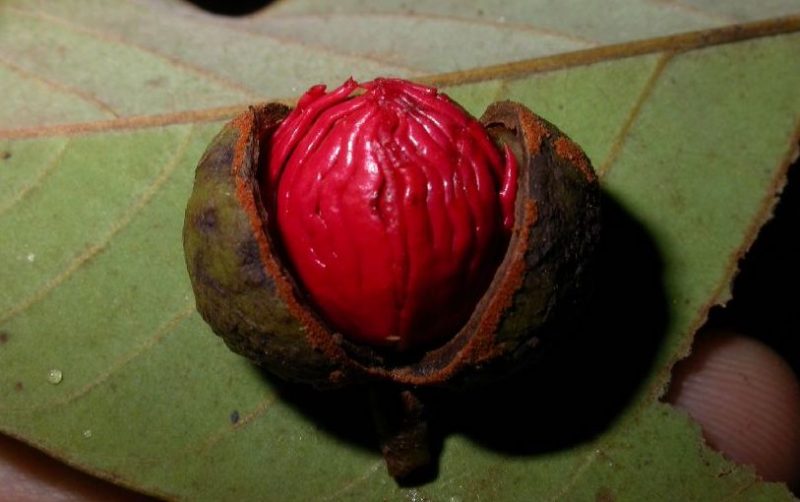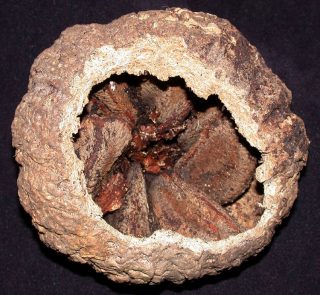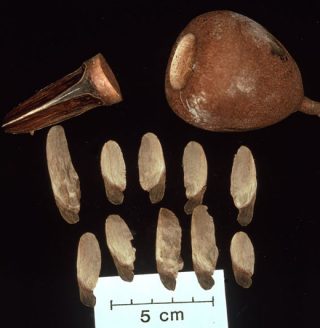What Is a Seed?
Lawrence M. Kelly, Ph.D., is Vice President for Science Administration and Susan E. Lynch Director of Graduate Studies at The New York Botanical Garden. Cecilia Zumajo is a graduate student in the Botanical Garden’s Pfizer Plant Research Laboratory.

Milkweed seeds with hairs
(Acsclepias incarnata)
If you follow Plant Talk or if you saw Cecilia’s paper on fruits, you know that fruits are the mature ripened ovaries of flowers. Many products commonly regarded as vegetables—such as cucumbers, bell peppers, eggplants, tomatoes, and green beans—are in fact fruits. Fruits enclose and protect seeds. So what is a seed?
The seed is the embryonic stage of the plant life cycle. Most seeds consist of three parts: embryo, endosperm, and seed coat. The embryo is a tiny plant that has a root, a stem, and one or more leaves. The endosperm is the nutritive tissue of the seed, often a combination of starch, oil, and protein. The seed coat is a protective covering that can help seeds remain viable for long periods of time.
While we often avoid the seeds when we eat fleshy fruits, many common dry food-products are seeds. That includes most edible legumes—peanuts, lentils, beans, and peas. A nut is technically a fruit, but we usually eat the seed and discard the fruit (or shell) when we eat our favorite nuts, such as cashews, walnuts, filberts, and pecans. Pine nuts, almonds, and Brazil nuts are also seeds—even though none of these comes from a nut. Some spices are seeds, including nutmeg, mustard, and fenugreek. Two of our favorite non-legume “beans”—coffee beans and cocoa beans—are seeds. What about grains, such as rice, corn, and cereal grains? Technically, grains are seeds that are fused to the ovary wall, so they are fruits, even though most of what we eat (and nearly all of the nutritional value) is the seed. Do not despair: many common seeds of commerce are, in fact, seeds, including poppy, flax, and pumpkin seeds.
Which plants have seeds?

The seed of Virola, a relative of nutmeg, is covered by a red fleshy layer.
Photo by Lawrence Kelly
Seeds are an important feature of the spermatophytes, or seed plants, which are subdivided into gymnosperms, or “naked-seeded” plants such as conifers and cycads, and angiosperms, flowering plants with seeds enclosed in ovaries. Examples of plants that lack seeds are ferns and mosses. Seed plants appear in the fossil record around 300 million years ago, and they are now the most abundant and diverse plant group on earth, with nearly 400,000 species.
Seeds come in a great variety of shapes and sizes, and a lot of the variation relates to dispersal mechanisms. One of the largest seeds, that of the coco de mer, is approximately a foot long and weighs up to 40 pounds. This seed floats, allowing it to disperse between islands in the Seychelles archipelago in the Indian Ocean. Some of the smallest seeds are those of epiphytic orchids, which are only 1/300th of an inch (85 micrometers) long—smaller than can be seen by the unaided eye. These seeds are dispersed in the air like minute dust particles. They lack endosperm and have tiny, underdeveloped embryos. Some seeds have fleshy appendages that entice animal dispersers to eat them; some have hooks, barbs, or sticky hairs that attach to fur or feathers; and some have wings for wind dispersal.
How do seeds develop?

Brazil nut fruit with seeds.
Courtesy of Creative Commons
Seeds form from a fertilized ovule after pollination. Despite the importance of seeds in the life cycle of plants—not to mention as food for humans and other animals—we know relatively little about the genetic control of the growth and development of seeds.
To date, most studies have been carried out on a single “model” species, Arabidopsis thaliana, which is an angiosperm in the mustard family (Brassicaceae). Studies of Arabidopsis have helped to identify the genes that are involved in the development of its ovule and seed, but the lack of broad studies across a diversity of plant groups makes it impossible to understand how plants have come to have such a wild array of seed types.
A group of researchers at The New York Botanical Garden is examining exactly this topic. By studying some of the genes involved in seed development—specifically those related to development of the seed coat—Cecilia and her collaborators are starting to understand one of the gene regulatory networks that plays an important and complicated role in seed development. They are also examining the evolutionary history of the genes involved because one important process in the evolution of gene networks is duplication and divergence of genes. Cecilia and her coauthors found that even though gymnosperms have a comparatively simple ovule and seed structure relative to angiosperms, they have more copies of the genes that control ovule and seed development. It is unclear what this means. Does it confer protection against deleterious mutations, or does it offer more potential for diversification? Cecilia’s results make it possible to understand the genetics of ovule and seed evolution, and the study provides an important foundation for broad molecular-genetic studies of non-model plant groups.

Winged seeds of Cariniana (Lecythidaceae), with fruit at top. Photo by Scott Mori
This research also offers a tiny glimpse into the vast realm of what we do not know about the inner workings of plants. Look at any plant in your backyard. We usually know what species it is, and we may have a very good idea of what other species it is related to. We can walk you through a simple summary of the most important features of its structure and how it is put together. But when it comes to questions about its most basic functions, including the genetic and evolutionary mechanisms of how it grows and survives in its environment, there are still many astounding discoveries to be made.
SUBSCRIBE
Enter your email address to subscribe to this blog and receive updates on new posts.











